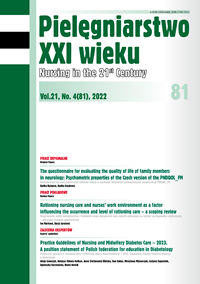Factors aff ecting the quality of mother-infant first contact after vaginal delivery
DOI:
https://doi.org/10.2478/pielxxiw-2022-0037Keywords:
birth, skin-to-skin contact, newbornAbstract
FACTORS AFFECTING THE QUALITY OF MOTHER-INFANT FIRST CONTACT AFTER VAGINAL DELIVERY
Aim. The primary objective of this study was to assess the infl uence of various factors on the fi rst contact of mother and her infant in Warsaw’s maternity facilities.
Material and methods. For this study, direct observation was performed. Research material was collected using original observation survey, specifi cally designed for this study. Study was conducted in 11 Warsaw’s maternity facilities of varied referral level.
Results. The contact was the longest (between 91 and 120 minutes) if there were fewer people present in the delivery room Turing birth (p<0.001). Infant was placed on mother’s chest immediately after delivery if there were fewer people present in the delivery room (p<0.001). Infant examination took place more than 2 hours after birth if there were fewer people present in the delivery room (p<0.001).
Conclusions. Mother-infant fi rst contact was the longest and was initiated immediately after delivery if there were fewer pe ople present in the delivery room and if a midwife was a sole provider of care.
References
1. Świetliński J. red. Neonatologia. Warszawa: Wydawnictwo Lekarskie PZWL; 2021, s.73-89.
2. Nehring-Gugulska M, Żukowska-Rubik M, Pietkiewicz A. Karmienie piersią w teorii i praktyce. Podręcznik dla doradców i konsultantów laktacyjnych oraz położnych, pielęgniarek i lekarzy. Kraków: Medycyna Praktyczna; 2017, s.85-93.
3. Standardy opieki medycznej nad noworodkiem w Polsce. Zalecenia Polskiego Towarzystwa Neonatologicznego. Wydanie III zaktualizowane i uzupełnione. Warszawa: Wydawnictwo Media-Press; 2019, s.15-22.
4. Cadwell K, Brimdyr K, Phillips R. Mapping, Measuring, and Analyzing the Process of Skin-to-Skin Contact and Early Breastfeeding in the First Hour After Birth. Breastfeed Med. 2018;13(7): 485-492. DOI: 10.1089/bfm.2018.0048.
5. Safari K, Saeed AA, Hasan SS, et al. The effect of mother and newborn early skin-toskin contact on initiation of breastfeeding, newborn temperature and duration of third stage of labor. Int Breastfeed J. 2018;13(32). DOI: 10.1186/s13006-018-0174-9.
6. Brimdyr K, Cadwell K, Stevens J, Takahashi Y. An implementation algorithm to improve skin-to-skin practice in the first hour after birth. Matern Child Nutr. 2017;14(2). DOI: 10.1111/mcn.12571.
7. Feldman-Winter L, Goldsmith JP. Safe Sleep and Skin-to-Skin Care in the Neonatal Period for Healthy Term Newborns. Pediatrics. 2016;138:(3). DOI: 10.1542/ peds.2016-1889.
8. Cleveland L, Hill CM, Pulse WS. Systematic Review of Skin-to-Skin Care for Full-Term, Healthy Newborns. JOGNN. 2017;46(6): 857-869. DOI: 10.1016/j.jogn.2017.08.005.
9. Feldman R, Rosenthal Z, Eidelman AI. Maternal-preterm skin-to-skin contact enhances child physiologic organization and cognitive control across the first 10 years of life. Biol Psychiatry. 2014;75(1): 56-64. DOI: 10.1016/j.biopsych.2013.08.012.
10. Widström AM, Lilja G, Aaltomaa-Michalias P, et al. Newborn behaviour to locate the breast when skin-to-skin: A possible method for enabling early self-regulation. Acta Paediatr. 2011;100: 79-85. DOI: 10.1111/j.1651-2227.2010.01983.x.
11. Jakobsson HE, Abrahamsson TR, Jenmalm MC, et al. Decreased gut microbiota diversity, delayed Bacteroidetes colonisation and reduced Th1 responses in infants delivered by caesarean section. Gut. 2014;63(4): 559-566. DOI: 10.1136/ gutjnl-2012-303249.
12. Guala A, Boscardini L, Visentin R, et al. Skin-to-skin contakt in cesarean birth and duration of breastfeeding: a cohort study. Scientific World Journal. 2017;1940756. DOI: 10.1155/2017/1940756.
13. Brady K, Bulpitt D, Chiarelli C. An interprofessional quality improvement project to implement maternal/infant skin-to-skin contact during cesarean delivery. JOGNN. 2014;43(4): 488-496. DOI: 10.1111/1552-6909.12469.
14. Cantrill RM, Creedy DK, Cooke M, et al. Effective suckling in relation to naked maternal-infant body contact in the first hour of life: An observation study. BMC Pregnancy Childbirth. 2014;14(1): 14-20. DOI: 10.1186/1471-2393-14-20.
15. Chantry CJ, Eglash A, Labbok M. ABM position on breastfeeding-revised 2015. Breastfeed Med. 2015;10(9): 407-411. DOI: 10.1089/bfm.2015.29012.cha.
16. Adamska-Sala I, Pietrasiewicz J. Raport z monitoringu oddziałów położniczych. Opieka okołoporodowa w Polsce w świetle doświadczeń kobiet. Warszawa: Fundacja Rodzić po Ludzku; 2018, s.48-59.
17. Schindler P, Burgos R, Vuong K, et al. The Process of Intrapartum Care Among Skilled Birth Attendants in the Dominican Republic and Maternal Perceptions of Care During Labor and Birth: A Case Report. JMWH. 2017;62(5): 599-606. DOI:10.1111/ jmwh.12633.
18. Rabiej M, Mazurkiewicz B. Pielęgnowanie w położnictwie, ginekologii i neonatologii. Warszawa: Wydawnictwo Lekarskie PZWL; 2018, s.47-50.
19. Doroszewska A, Nowakowski M. Medykalizacja opieki okołoporodowej w Polsce. Zd Publ Zarządzanie. 2017;15(2): 172-177.
20. Lawrence A, Lewis L, Hofmeyr G, et al. Maternal position and mobility during first stage labour. Cochrane Databaze Systematic Reviews 2013,10: DOI: 10.1002/14651858.CD003934.pub3.
21. Simkin P, Ancheta R. The Labor Progress Handbook: Early Interventions to Prevent and Treat Dystocia. Warszawa: Wydawnictwo Lekarskie PZWL; 2014, s.284-334.
22. Louwen F, Daviss BA, Johnson KC, et al. Does breech delivery in an upright position instead of on the back improve outcomes and avoid cesareans? Int J Gynaecol Obstet. 2017;136(2): 151‐161. DOI: 10.1002/ijgo.12033.
23. Doroszewska A. Opieka okołoporodowa w Polsce po transformacji ustrojowej – między medykalizacją a demedykalizacją? Annales Universitatis Marie CurieSkłodowska. 2016; Vol XLI (2) sectio I. DOI: http://dx.doi.org/10.17951/i.2016.41.2.47.
24. Szczapa J. red. Neonatologia. Warszawa: Wydawnictwo Lekarskie PZWL; 2019, s.19-20.
Downloads
Published
Issue
Section
License
Copyright (c) 2022 Authors

This work is licensed under a Creative Commons Attribution 4.0 International License.




